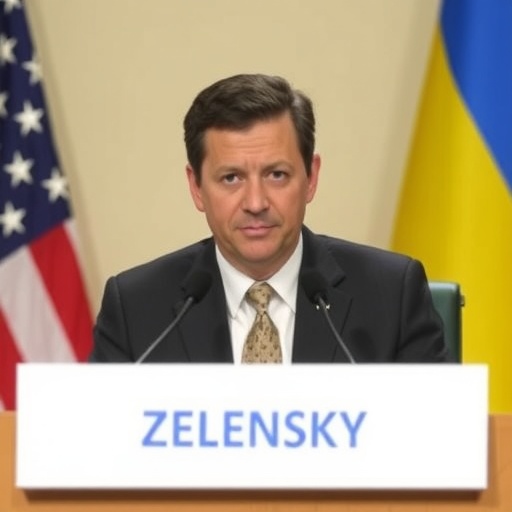Zelensky Urges US to Escalate Sanctions on Entire Russian Oil Sector for Ukraine’s Defense
In a bold and urgent plea amid the escalating conflict in Eastern Europe, Ukrainian President Volodymyr Zelensky has called on the United States to dramatically expand its sanctions regime against Russian oil, moving beyond the current restrictions on just two major companies to encompass the entire sector. This appeal, delivered during a virtual address to U.S. policymakers on Thursday, underscores Zelensky‘s frustration with the pace of international support for Ukraine as Russian forces continue their aggressive advances. “Sanctions must hit where it hurts—Russia’s oil lifeline that funds their war,” Zelensky stated, emphasizing that targeted measures alone are insufficient to curb Moscow’s military ambitions.
The request comes at a critical juncture, with reports indicating that Russia has rerouted much of its oil exports to evade existing penalties, maintaining a steady flow of revenue estimated at over $100 billion annually from energy sales. Zelensky’s push highlights the intertwined fates of US sanctions and the broader geopolitical struggle, where every barrel of oil sold by Russia translates into ammunition and resources for the front lines in Ukraine.
Zelensky’s Fiery Address Demands Total Oil Sector Crackdown
President Zelensky’s address was nothing short of a clarion call, delivered with the raw emotion that has become his hallmark since Russia’s full-scale invasion began in February 2022. Speaking from Kyiv, he recounted the daily toll on Ukrainian civilians and soldiers, painting a vivid picture of destruction in cities like Kharkiv and Donetsk. “While our people shelter in basements from missile strikes, Russia’s oligarchs and generals profit from unchecked oil sales,” he said, his voice laced with determination. This personal narrative resonated deeply, reminding listeners of the human cost behind the economic levers of power.
Zelensky specifically criticized the U.S. Treasury’s recent sanctions on Sovcomflot, Russia’s state-owned shipping company, and a single refiner, arguing they represent mere pinpricks. “We need a full embargo on Russian oil processing, shipping, and financing—not half-measures that allow loopholes,” he urged. Drawing on data from the International Energy Agency, Zelensky noted that despite Western sanctions, Russia exported 7.7 million barrels per day in the first half of 2023, a figure that has barely dipped from pre-war levels. This persistence, he argued, is due to shadowy deals with countries like China and India, which now absorb over 80% of Moscow’s crude exports.
The Ukrainian leader’s plea was timed strategically, coinciding with ongoing debates in the U.S. Congress over supplemental aid packages. Zelensky referenced a recent poll by the Kyiv International Institute of Sociology, where 92% of Ukrainians expressed support for tougher international sanctions, reflecting domestic pressure that amplifies his international advocacy. His words echoed through Washington corridors, where lawmakers like Senate Foreign Relations Committee Chair Bob Menendez have voiced similar sentiments, calling for “maximum pressure” on Russia’s energy sector to hasten an end to the conflict.
Navigating the Limits of Current US Sanctions on Russian Energy
The existing framework of US sanctions on Russian oil has evolved since the invasion but remains fragmented, targeting specific entities rather than the ecosystem as a whole. In December 2022, the Biden administration imposed a $60 per barrel price cap on Russian crude, enforced through penalties on third-party facilitators. This measure, coordinated with the G7, aimed to squeeze Russia’s revenues without spiking global energy prices. However, enforcement challenges persist: the U.S. has sanctioned only two oil giants—Rosneft and Gazprom Neft—leaving giants like Lukoil and Surgutneftegas relatively unscathed.
According to a report from the U.S. Energy Information Administration (EIA), these targeted sanctions have reduced Russia’s oil revenues by about 30% from peak levels, yet the country still generated $181 billion from fossil fuels in 2022 alone. Experts point to evasion tactics, such as using a “shadow fleet” of over 600 aging tankers to bypass Western insurance and tracking. “The sanctions are like a leaky dam—effective in parts, but the flood of cash continues,” said Meghan O’Sullivan, a Harvard energy policy expert, in a recent interview with Bloomberg.
Zelensky’s call for expansion would involve secondary sanctions on foreign banks and insurers dealing in Russian oil, a step the U.S. has hesitated to take due to fears of alienating allies in Asia. Historical context reveals the sanctions’ roots in earlier measures post-Crimea annexation in 2014, which were mild by comparison. Today, with Ukraine’s grid under constant bombardment—over 50% of its energy infrastructure damaged—the urgency for broader action is palpable. Ukrainian officials estimate that a full sector ban could cut Russia’s war funding by an additional $40 billion yearly, enough to equip thousands more troops on the front.
- Key Current Sanctions: Price cap on seaborne crude; bans on new investments in Russian energy; restrictions on technology exports for oil extraction.
- Gaps Identified: No comprehensive ban on refined products; limited action against non-Western buyers; insufficient penalties for shadow shipping.
- Impact Stats: Russia’s oil exports to EU fell 90% post-invasion, but overall volumes rose via pivots to Asia.
This section of Zelensky’s agenda ties directly into his broader narrative of Ukraine as a frontline defender of democratic values against authoritarian aggression, urging the U.S. to view sanctions not as an economic tool but as a weapon in the information and hybrid warfare era.
Russian Oil Revenues Fueling the Ukraine Invasion Machine
At the heart of Zelensky’s urgency lies the undeniable link between Russian oil profits and the Kremlin’s war chest. Since the invasion, Moscow has repurposed its energy sector as the primary financier of military operations, with oil and gas accounting for nearly 40% of federal budget revenues in 2023, per Russia’s own finance ministry data. This influx has enabled the production of advanced weaponry, including hypersonic missiles that have terrorized Ukrainian skies.
A detailed analysis by the Centre for Research on Energy and Clean Air (CREA) reveals that in the first eight months of 2023, Russia earned €126 billion from fossil fuel exports, €24 billion more than the previous year despite sanctions. “Every tanker leaving Novorossiysk port carries not just oil, but the means to prolong suffering in Ukraine,” Zelensky remarked, invoking the Black Sea port’s role in evading scrutiny. The economic resilience stems from discounted sales—China buys Russian Urals crude at $10-15 below Brent benchmarks—allowing Moscow to maintain volumes while undercutting global markets.
From a strategic viewpoint, expanding US sanctions could disrupt this cycle. Modeling by the Atlantic Council suggests that a total ban on Russian oil imports by G7 nations, coupled with secondary measures, might reduce Moscow’s GDP by 5-7% in the first year, forcing budget reallocations away from military spending. Ukrainian military analysts corroborate this, noting that Russia’s daily oil revenue of $500 million directly supports logistics for 1.2 million troops deployed along the 1,000-kilometer front line.
Yet, challenges abound. Russia’s pivot to BRICS partners has created new dependencies, with India alone importing 1.5 million barrels daily. Zelensky addressed this in his speech, calling for U.S. diplomacy to persuade New Delhi and Beijing of the moral imperative. Internally, Russia’s economy shows strain— inflation at 7.5%, ruble volatility—but oil remains the buffer. As one anonymous Kremlin insider leaked to Reuters, “Oil is our oxygen; without it, the war machine stalls.”
Amplifying Military Support Alongside Economic Pressure
Zelensky’s sanctions plea is inextricably linked to his renewed demands for enhanced military aid to Ukraine. “Sanctions weaken Russia externally; weapons empower us internally,” he declared, referencing the U.S.’s $61 billion aid package approved in April 2024, which included ATACMS missiles but fell short of F-16 fighters. The president highlighted recent battlefield successes, like the incursion into Russia’s Kursk region, as evidence that more support could tip the scales.
U.S. officials, including Secretary of State Antony Blinken, have acknowledged the synergy: tougher US sanctions on Russian oil reduce Moscow’s ability to replenish stocks, while aid bolsters Kyiv’s defenses. Statistics from the Kiel Institute for the World Economy show the U.S. leading in lethal aid, providing 59% of Ukraine’s total military support since 2022—over $50 billion in weapons and training. However, delays in delivery, such as the postponed Patriot systems, have drawn Zelensky’s ire.
In his address, Zelensky outlined specific needs: long-range artillery to strike oil depots, cyber tools to disrupt export networks, and joint exercises to integrate NATO-standard equipment. He praised the recent U.S.-Ukraine security pact but warned that without escalation on sanctions, aid alone won’t suffice. “Russia adapts; we must outpace them,” he said. Experts like Michael Kofman from the Carnegie Endowment agree, noting in a Foreign Affairs op-ed that comprehensive oil sanctions could shorten the war by 6-12 months by starving Russia’s industrial base.
- Recent Aid Milestones: Delivery of 31 Abrams tanks; 155mm artillery shells totaling 2 million rounds.
- Pending Requests: 100+ F-16s from allied stockpiles; expanded use of U.S. weapons inside Russia.
- Synergistic Effects: Sanctions could force Russia to divert oil revenues to imports, easing pressure on Ukrainian forces.
This dual-track approach—economic strangulation paired with military fortification—positions Zelensky’s vision as a holistic strategy against Russia‘s aggression.
Global Echoes and Pathways to Heightened Pressure on Russia
Zelensky’s appeal has rippled across the international stage, eliciting responses from European allies and even neutral players. The European Union, which banned all seaborne Russian oil imports in December 2022, echoed the call through Commission President Ursula von der Leyen, who stated, “We stand with Ukraine; broader U.S. action would amplify our efforts.” Yet, divisions persist: Hungary and Slovakia, reliant on Russian pipelines, have blocked full EU embargoes on refined products.
In Asia, reactions are mixed. India’s External Affairs Minister S. Jaishankar defended continued purchases as “energy security,” but U.S. pressure via trade talks could shift dynamics. A United Nations report estimates that global oil prices could rise 5-10% with escalated sanctions, prompting concerns from OPEC+ members. Nonetheless, environmental groups like Greenpeace support the move, arguing it accelerates the shift from fossil fuels while weakening a pariah state.
Looking ahead, the Biden administration faces a ticking clock with U.S. elections looming, where Ukraine aid has become politicized. Zelensky plans follow-up visits to Washington, potentially influencing the next aid bill. Analysts forecast that if implemented, expanded sanctions could force Russia into negotiations by mid-2025, as oil revenues plummet and domestic unrest grows—evidenced by recent protests in oil-rich Siberia over unpaid wages.
The path forward hinges on unity: U.S. lawmakers must balance domestic inflation fears with moral leadership. As Zelensky concluded, “The free world decides now—sanction Russia’s oil lifeline, arm Ukraine decisively, and end this nightmare sooner.” This convergence of economic warfare and military resolve offers a beacon of hope amid the fog of war, potentially reshaping the conflict’s trajectory for generations.









